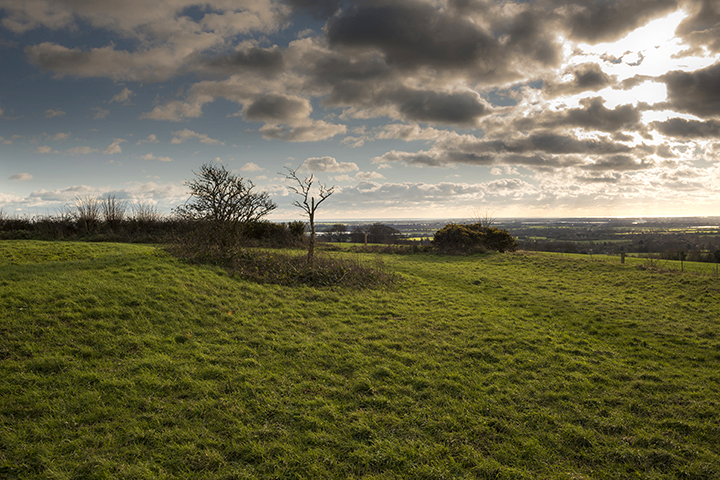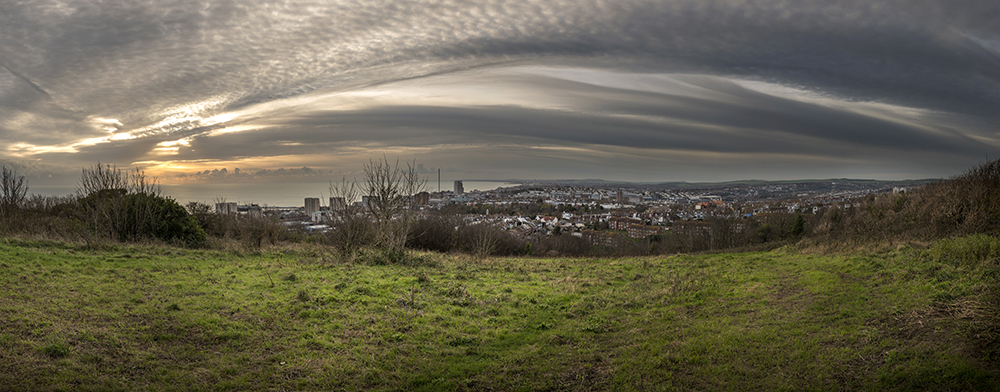
Old photo from 1894 showing fallen stones.
dartmoortrust.org/archive/view/3460

Old photo from 1894 showing fallen stones.
dartmoortrust.org/archive/view/3460

It took a little longer than anticipated to find this beauty, but thanks to some local rangers we sorted out where we were and eventually stumbled on it. And we were not disappointed.

Panorama from East to West. There seems to be an obvious gap, or missing stone, at this end. I know that the largest stones were re-erected earlier in the 20th Century. I wonder if one had gone missing over the centuries?

Looking back along the row westwards to the cairn circle.

Nice days cycle over the Downs. Wolstonbury Hill is, I think, directly behind the barrow.

I found this site slightly confusing. Is this ‘The Giant’s Grave’ within this copse or is it the barrow slightly further up the track that looks, from a distance, like a long barrow. Either way, lovely spot.

The barrow further up the track from the copse. Long barrow or a round barrow slightly truncated by the track? Who knows?

This one’s all but disappeared and is situated just outside the copse.

Captured by my son with his drone last week while working near Dorchester.

I came here about 8 months ago and it was all completely dry , including the trickle from Silbury Hill which I walked back along. Look at it now though, you can’t even get across it via the large sarsens laid down there! Interesting that a lot of these rivers are winterbournes, but this one thrives in the spring/summer.....hmmm.



Large sarsen built into someones back garden steps overlooking the Tye about 100m from the church.

Large sarsen built into a garden wall approximately 400m from the church. It looks like two stones from a distance but it’s just a natural fissure viewed close-up.

The banded quartz stone on the South side of the circle.



The public swimming pool recently opened within the circle.



Sunburst over Chichester and Selsey viewed from the South Western entrance to The Trundle.

Panorama showing almost all of the stones remaining in an arc. The others are gathered together further back in the wood.

Feels like a half finished job here, a bit like the circle itself. It might have been nicer to completely clear the imposing trees or, better still, have left the circle alone as it seems to have lost some of it’s mystery.

The approach to Halnaker Hill from Stane Street. The hill gets it’s name from the nearby Halnaker village and the name is derived from ‘half naked’ apparently. Curious.

Looking East across the 19th Century dew pond. Note the WWII structure in the background, one of three, which was either for a search light or RDF equipment.

The bank on the left is probably not ancient and maybe contemporary with the post mill of 1740.

The edge of the enclosure is defined by the fence and bank on the right.

The Southern entrance is just beyond the dew pond on the left hand side.

While making our way up the track to Court Hill we passed these ancient droving tracks descending from the South Downs to the village of East Dean.


The raised bank disappearing through the fence into the copse.

The Trig point which stands on the South Western edge of the enclosure.

Looking out South West you can see Goodwood Race Course and The Trundle.

Peering into the copse you can just about make out the raised bank of the enclosure.

The dip in the railings of the Race Course run-off track indicate the faint remains of the 3rd ring of the Causewayed Enclosure.

One of the areas dug in August 2014 on Whitehawk Hill, sadly yielding very little.

The view over Brighton & Hove from Whitehawk Hill. This is the same section that was dug in August 2014 in the previous photo.

The centre of the site is near the road (Manor Hill) that bisects the site, just South of Brighton Race Course. The notorious Whitehawk estate lies in the valley beyond, source of many burnt offerings.

Approximately between the 3rd and 4th ring with the communications mast to the South.

Setting sun, thundering jets and solid stone.

Panorama of big stones and long shadows, late September.


The car park was chocca, but the rings largely absent of people. Do people genuinely drive to these places and stay in their cars?



Yet another glorious sunset on what has become an almost yearly pilgrimage to Five Barrows in conjunction with working at the AJ Wells enamelling factory at Newport. You can’t beat it!

A charming saucer barrow on the Eastern limit of the cemetery.

This curiosity is on the other side of the valley from the barrows, about half a miles walk from the barrows. It may once have stood and is about 1.5m in length and made of a strange highly iron-infused sandstone. There are lots of boulders of the same material further below on the beach at Compton Bay.